United States, October 1, 2025
News Summary
A growing shortage of homes has pushed new construction to the forefront, but many banks are retreating from speculative ground-up projects. Private capital is filling that financing gap by offering faster closings, flexible underwriting and phased, performance-based funding tied to construction milestones. Although private construction loans often carry higher rates, quicker draws and localized project expertise can reduce delays, lower carrying costs and improve returns. Regional trends show strong demand in the Southeast and Sun Belt while multifamily pipelines have cooled. Heat-safety rules and scarce shovel-ready lots also shape schedules and labor availability for builders.
Private Capital Steps In as Banks Retreat; Heat-Safety Rules and Apartment Supply Shift Housing Market
The U.S. housing market is adjusting as traditional banks reduce their role in new-home financing and private capital becomes the primary engine for ground-up construction. At the same time, evolving local and state rules about worker heat protections and a slowdown in apartment building are reshaping where and how homes get built.
Top takeaways
Private lenders are filling a growing gap in construction finance by offering speed, flexibility and local market know-how. Faster closings and rapid draw disbursements help builders move projects forward. Meanwhile, legal preemption in several states is limiting local heat-safety rules for outdoor workers, raising safety concerns for crews working in rising temperatures. At the same time, the pipeline for multifamily construction has contracted sharply from its recent peak, reshaping rental supply and rent trends across regions.
Why private capital is moving to the front of ground-up building
Banks once dominated new-home construction lending, but heightened regulation, long approval timelines and low tolerance for speculative projects have reduced their appetite for ground-up work. Private lenders now commonly step in, offering underwriting that emphasizes the asset and the deal’s viability rather than borrowers’ personal income or credit history.
The practical advantage of private capital is its speed. Many private lenders can move from initial inquiry to closing in weeks and complete closings in under two weeks in competitive cases. Modern draw processes tied to underwriting and powered by technology can cut disbursement times from days to hours, keeping crews on schedule and preventing construction delays that can otherwise add cost.
Private lenders also write tailored programs and can structure projects into smaller, performance-based phases tied to construction milestones. This creative structuring helps manage risk and keeps projects aligned with cash flow and market demand. While private lending rates are typically higher than bank rates, the total project savings from quicker construction, earlier sales and fewer delays often outweigh higher interest costs.
How private lenders manage construction risk
Leading private lenders perform detailed due diligence before funding: they analyze architectural plans, verify budgets, review draw schedules and assess permitting, infrastructure and timing risks. Balance-sheet lenders often retain control over the draw process and loan management, providing continuity and accountability through project completion. That continuity can be critical for builders who benefit from a single point of contact and a lender able to scale across multiple projects.
Geography and demand: where construction is moving
Demand for new construction remains strong in fast-growing regions, particularly in the Southeast and Sun Belt, where migration and less restrictive land-use rules have encouraged development. Many homebuyers are millennials entering the market and baby boomers downsizing, supporting demand across price points. By contrast, geographic constraints in the Northeast limit new development, and renovation work still dominates in many Midwestern and older industrial markets.
Multifamily pipeline shows a sharp pullback
Recent industry data show the number of apartment units under construction has declined sharply from its peak in early 2023. Headlines on multifamily trends note a nearly 50% reduction from that peak. Overall, the nation is on track to build roughly a half-million multifamily units in the referenced year, with much of recent multifamily growth concentrated in Southern and Sun Belt metros. The influx of new supply in some markets has helped ease rent pressure, with rents in many Southern metros flattening or falling modestly year over year, while other regions see moderate rent gains.
Heat-safety preemption laws and worker safety
Heat safety is an increasing concern for construction and maintenance workers as the number and intensity of extreme-heat days rises. Several states have passed laws that prevent local governments from enacting stricter outdoor-worker break and cooling requirements than state rules. These state-level preemption measures have reduced the ability of cities and counties to require extra water, shade or rest breaks, prompting safety and labor advocates to warn of rising risks for outdoor crews.
Local ordinances that require rest, shade and water for outdoor workers remain rare in many parts of the country, though some cities have adopted strong protections without state interference. Federal rulemaking on heat protections is in progress, with an agency final public comment period scheduled in the coming year; any federal standards would apply nationwide and could supersede state preemption limits.
On-the-ground heat risks and construction work
Road paving and asphalt work create significant localized heat beyond ambient air temperatures. Freshly laid hot mix asphalt can exit trucks at temperatures of several hundred degrees, and pavement surfaces can run dozens of degrees hotter than the air on sunny days. Field observations have shown measured working-surface and equipment temperatures well above reported air temperatures, highlighting the need for practical protections on jobsites.
What this means for builders, contractors and investors
The shortage of shovel-ready lots and a pullback in conventional construction finance mean success generally requires strong partnerships among developers, brokers, originators and lenders. Aligning with private lenders who understand ground-up development can be decisive. For contractors stepping into development, private capital can provide growth pathways by lending against experience and past work rather than just corporate track records.
For those seeking more information or contact details related to lending services referenced in this report: P.O. Box 692, Bothell, WA 98041-0692 | Phone: (800) 297-6061.
Author note
This article was written by Kevin Rodman, CEO at a private lending firm, who brings more than 38 years of experience in mortgage lending and real estate, including extensive senior roles at a major investment bank and mortgage servicing operations prior to joining the current firm in 2014.
FAQ
Q: Why are banks pulling back from construction lending?
A: Banks face stricter regulation, require more documentation and generally have lower tolerance for speculative projects or unentitled land. These factors slow approvals and limit bank participation in ground-up development.
Q: What advantages do private lenders offer?
A: Private lenders offer faster closings, flexible underwriting tied to the asset, creative phasing options, and quicker draw disbursements. They prioritize project viability and local market insight over borrower credit alone.
Q: Are private loans more expensive?
A: Interest rates can be higher than bank loans, but the overall project savings from faster construction, reduced holding costs and earlier sales often offset higher interest expenses.
Q: How do heat-safety preemption laws affect construction sites?
A: Preemption laws can block local rules that require extra water, shade and rest breaks for outdoor workers, potentially increasing health risks on hot days. Some cities retain the ability to pass protections where state law allows.
Q: What is the status of apartment construction?
A: The multifamily pipeline has contracted significantly from recent highs, with fewer units under construction than at the 2023 peak. This will slow new rental supply growth in many markets, though past years’ strong building activity still influences local rent levels.
Q: How can builders find private capital?
A: Builders should seek lenders with experience in new construction, ask for references, and look for balance-sheet lenders who manage draws directly. Brokers and originators who specialize in construction finance can help match projects with suitable private capital.
{
“@context”: “https://schema.org”,
“@type”: “FAQPage”,
“mainEntity”: [
{
“@type”: “Question”,
“name”: “Why are banks pulling back from construction lending?”,
“acceptedAnswer”: {
“@type”: “Answer”,
“text”: “Banks face stricter regulation, require more documentation and generally have lower tolerance for speculative projects or unentitled land, which slows approvals and limits participation in ground-up development.”
}
},
{
“@type”: “Question”,
“name”: “What advantages do private lenders offer?”,
“acceptedAnswer”: {
“@type”: “Answer”,
“text”: “Private lenders offer faster closings, flexible underwriting tied to the asset, creative phasing options, and quicker draw disbursements while prioritizing project viability and local market insight.”
}
},
{
“@type”: “Question”,
“name”: “Are private loans more expensive?”,
“acceptedAnswer”: {
“@type”: “Answer”,
“text”: “Private loan interest rates can be higher than bank loans, but faster construction, reduced holding costs and earlier sales often offset the higher interest expense, resulting in comparable or better net outcomes.”
}
},
{
“@type”: “Question”,
“name”: “How do heat-safety preemption laws affect construction sites?”,
“acceptedAnswer”: {
“@type”: “Answer”,
“text”: “Preemption laws can block local rules requiring extra water, shade and rest breaks for outdoor workers, potentially increasing heat-related health risks; federal rulemaking could change the landscape.”
}
},
{
“@type”: “Question”,
“name”: “What is the status of apartment construction?”,
“acceptedAnswer”: {
“@type”: “Answer”,
“text”: “The multifamily pipeline has contracted significantly from recent highs, slowing new rental supply growth in many markets even as previously built units continue to affect local rent levels.”
}
},
{
“@type”: “Question”,
“name”: “How can builders find private capital?”,
“acceptedAnswer”: {
“@type”: “Answer”,
“text”: “Builders should seek lenders experienced in new construction, look for balance-sheet lenders who manage draws directly, and work with brokers or originators who specialize in construction finance.”
}
}
]
}
Key features at a glance
| Feature | What it means | Impact |
|---|---|---|
| Private capital speed | Closings in weeks; rapid draw disbursements | Reduces delays, enables quicker sales and revenue |
| Flexible underwriting | Deals structured around asset and milestones | Allows atypical projects to get funded |
| Higher rates vs. banks | Higher interest but faster execution | Total cost often lower due to time savings |
| Multifamily pipeline contraction | Units under construction down sharply from peak | Slower future rental supply growth; mixed rent trends |
| Heat-safety preemption | State laws limiting local worker protections | Potential increase in worker heat injuries; local policy limits |
| Balance-sheet lenders | Maintain draw control and loan management | Consistency and accountability through build |
| Permitting risk | Varies by jurisdiction; can slow projects | Major factor in lender decisions and timelines |
| Builder-contractor partnerships | Investors provide capital; contractors provide build expertise | Enables less experienced developers to scale |
Deeper Dive: News & Info About This Topic
Additional Resources
- CoStar: After leading US in multifamily construction for years, Sun Belt sees biggest plummet in building activity
- Wikipedia: Multifamily housing
- ForConstructionPros: Heat safety rollbacks endanger road crews in the Sunbelt
- Google Search: heat safety rollbacks road crews Sun Belt
- GlobeSt: Sun‑Belt cities dominate the build‑to‑rent housing wave
- Google Scholar: build-to-rent Sun Belt
- Business Insider: Rents falling in southern Sunbelt cities as apartment building rises
- Encyclopedia Britannica: Search — Sun Belt housing market
- Reason (Volokh): NIMBYism stifles housing construction in previous growth areas
- Google News: NIMBYism housing construction Sun Belt
Author: Construction CA News
The CALIFORNIA STAFF WRITER represents the experienced team at constructioncanews.com, your go-to source for actionable local news and information in California and beyond. Specializing in "news you can use," we cover essential topics like product reviews for personal and business needs, local business directories, politics, real estate trends, neighborhood insights, and state news affecting the area—with deep expertise drawn from years of dedicated reporting and strong community input, including local press releases and business updates. We deliver top reporting on high-value events such as the Rose Parade, Coachella, Comic-Con, and the California State Fair. Our coverage extends to key organizations like the California Building Industry Association and Associated General Contractors of California, plus leading businesses in technology and entertainment that power the local economy such as Apple and Alphabet. As part of the broader network, including constructionnynews.com, constructiontxnews.com, and constructionflnews.com, we provide comprehensive, credible insights into the dynamic landscape across multiple states.




